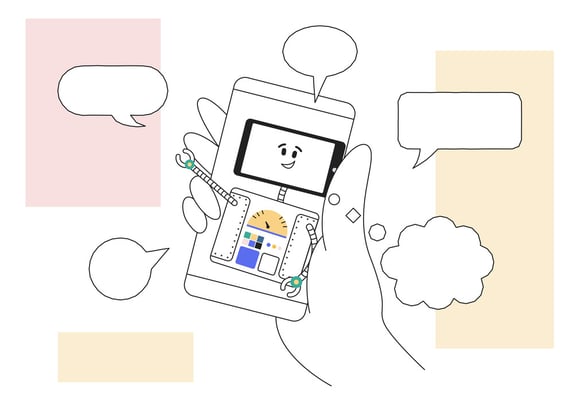Small businesses are inundated with social media advice. You’ve doubtlessly read about a million and one things you could be doing to boost customer engagement, reach new markets and help you rank on Google.
But have you done any of them yet? Thought not.
Social media is fiddly and time-consuming. And while it’s certainly critical for successful marketing, its effects are difficult to measure when it comes to straight up ROI.
That’s why we’ve created the small business 30-day social media challenge. It’s simple: 30 small, easily achievable steps to help you get your social media feet wet without drowning in #hashtag overload.
None of these tasks should take more than 30 minutes. Most will take a lot less. So what are you waiting for? Let’s get started:
Articulate’s 30-day social media challenge
Day 1: Revisit your personas and see what social media channels they are most likely to use. You do have personas right? If not, you need to take a step back and get that sorted before you embark on this challenge. You can learn how to develop a persona, here.
Social media isn’t about blasting out messages for the sake of it; it’s about targeting the right customers, in the right place, with the kind of messages they want to see. If you don’t know who they are, you haven’t got a chance.
Day 2: Look for your customers. Personas are great, but they’re hypothetical. That’s why you need to look to your existing customers as well and investigate their digital habits. What channels are they on? Do they just use corporate accounts or do key individuals have personal accounts? What kinds of things do they comment on and share? Who do they interact with? Make a list.
Day 3: Here’s an easy one for you: check what social media accounts your business already has. Is there a dusty Twitter profile hanging around? It’s very possible some intern or enthusiastic new hire set up an account a few moons ago and forgot to tell anyone about it - after all, nearly 25 million Twitter users are not doing anything on Twitter. So gather your inventory and reset all your passwords so you can log in to all of them.
Day 4: Decide which two social media channels to focus on first. Your work from day one and two will tell you where it’s worth focusing your time, while day three’s research will highlight if they match with any dormant accounts that already have an audience worth re-engaging with.
Day 5: Set up or polish your chosen accounts. This means making sure your profile has an up-to-date company description, logo, contact details and profile image. Here’s a great cheat sheet for all the image sizes you’re likely to need, and here’s how to write great social media bios.
Day 6 and 7: It’s the first weekend of the challenge so we’ll just give you one task: choose an RSS feed tool and populate it with your favourite sites.
Now, this doesn’t mean curating shiny motorbike fan sites or avocado, avocado, avocado health sites. It means pulling together blogs that are relevant to your industry and your personas. So take a bit of time building up a little library that you can draw on for that all-important third party sharing you’ll be doing next week.
Day 8: Sign up for Buffer or CoSchedule and hook it up to your chosen social media channels. Afterwards, set the sharing schedules to post out a couple of times a day. This is a great tool for creating a backlog of posts that will go out regularly so you don’t have worry about posting something every day.
Day 9: Line up a week’s worth of social curation from your RSS feed. What do we mean by that? Scan through your RSS feed for recent blogs you think your personas would be interested in and share them using Buffer. Since you’ve set up the sharing times already, once you’ve shared 14 or so, you’ll have a week’s backlog of content ready to roll.
Day 10: Pull together all the images you have scattered across your company. It could be employee profiles, recent events, office shots – anything you can share to tell people about yourself and your company. Share one.
Don’t have any images? Then take a picture of your workspace and share it – that’s always a classic.
Day 11: Ask people to sign up to your mailing list. If you give plenty through social media then it’s fine to occasionally ask for something back. After all, you want to draw these fans and followers to your site, convert them to leads and eventually win them over in to customers. So nothing ventured, nothing gained.
Day 12: Investigate hashtags. The weird and wonderful world of hashtags might seem baffling, but if you use Twitter, Instagram or even Facebook, you need to have an idea of which ones your personas actually respond to.
Look some up, see if the content they’re connected to matches the kind of content you want to share and be associated with. Then make a list of the most useful and popular hashtags for your industry. A useful guide to using hashtags can be found, here.
Day 13: Take an inventory of in-house content that you can share. This means blog posts, white papers, case studies, infographics, videos – anything that you’ve created to appeal to your personas. You’re going to use this inventory to share from, so make sure these things have live URLs or landing pages.
Day 14: Line up a week’s worth of your content to share on Buffer. Use the hashtags from day 12 where appropriate.
Up the number of shares per day through Buffer to three and schedule it so that for every piece of your content you share, you share two pieces of third-party content the same day.
Remember, social media platforms are communities where people have conversations. If you’re always talking about yourself, no one will listen.
Day 15: Follow your customers. This one is probably one of the most time consuming but valuable challenges. Most companies have links to their social profiles on their websites, so start with a list of your customer base and get searching.
If your customer base really is too big to tackle in one day (lucky you), start with your most valuable and long-standing customers and those you’ve acquired most recently.
Day 16: Top up that Buffer feed with another week’s worth of curated content from your RSS feed. Don’t let it run dry!
Day 17: Find influencers in your industry and customer market and follow them. Influencers are trusted authorities with large audiences and active social media profiles. You can find them using tools like Buzzsumo.
Connecting with influencers increases the chances that they will follow you back and hopefully share some of your content through their profile. Gradually, you’ll want to build relationships with these people, but that’s for tomorrow.
Day 18: Pick an influencer and comment on one of their posts. Don’t just comment for the sake of it, spend a bit of time finding something that you can usefully comment on and genuinely add value to. Then find another post that you think is worth sharing with your audience.
Day 19: Celebrate a customer. This can range from sharing a post they’ve put up about a recent success or mentioning them in a Tweet to praise them about an achievement. You could even introduce your audience to this customer and praise the amazing product or service they offer.
Day 20: Answer a question. Lots of people use social media to find recommendations and advice. Use the influencer circle you are part of, your customer feeds and the hashtags from day 12 to find a question that your business can usefully answer.
Don’t try and push a product. This isn’t a sales pitch; it’s you being useful and contributing to the community.
Day 21: Time to line up some more of your own content in Buffer. Aim for two weeks’ worth this time and try to include a mention of an influencer or a customer in a couple of the posts as they relate to the content in question.
For example, if you’re sharing a case study, tag the customer in question. Do you have a blog that quotes an influencer? Mention them in your share.
Day 22: Ask a question. Social media is a great place to learn more about your potential customers and their needs, so post a provocative question or set up a multiple choice that gets your followers engaging with you and which teaches you something useful in the process.
Day 23: You guessed it. It’s curation time on Buffer again.
Day 24: Share a top tip you’ve recently discovered in your business. This might be an app you’ve started using or a partner you’ve started working with. Remember: you’ve got to give a little to get a little.
Day 25: Cross-promote your social media channels. Just because someone stumbled across you on Twitter doesn’t mean they bothered looking for you on LinkedIn. And it could be that they only go on Twitter occasionally, but might regularly use LinkedIn when looking for business services. What a wasted opportunity! You want to reach the right people in the right places, so make sure people know where to find you.
Day 26: Post something funny. We all need a little light relief once in a while. Just make sure it’s in keeping with your company tone of voice and brand; there’s a big difference between a Grumpy Cat meme and a pithy New Yorker sketch.
Day 27: Post a link to an information page on your website. Pitch it as something interesting and useful to your audience along the lines of ‘Did you know we offered…? Or ‘Have you ever considered…?’ There's nothing wrong with a little self-promotion in moderation.
Day 28: Talk to your customers again and thank them; give them a shout out and show them how important they are. If you act as an evangelist for them they may well return the favour.
Day 29: Share a client testimonial or case study. You can’t beat social proof as a marketing tool. As an added bonus, ask the customer in question to share the case study on their channels too.
Day 30: Sit back and look at what worked. Social media is about sharing the right content at the right time on the right channel. Look through all you’ve done in the last month and see which actions drove traffic, leads or customers. Then take note of which actions got you noticed by influencers and new followers.
You've finished the social media challenge. Now what?
If these 30 days have brought you some success without too much sweat, look to the next 30 and refine and repeat. It's that simple. Just keep improving your content sharing process. And if you get stuck, download our beginner's guide to social media marketing for more tips and inspiration.
Want to learn more? Here's some further reading:





